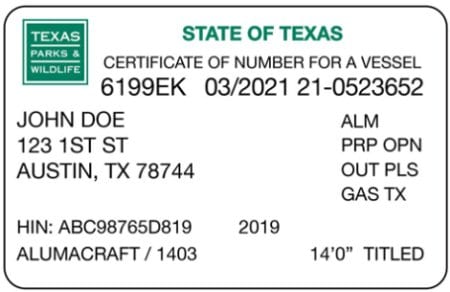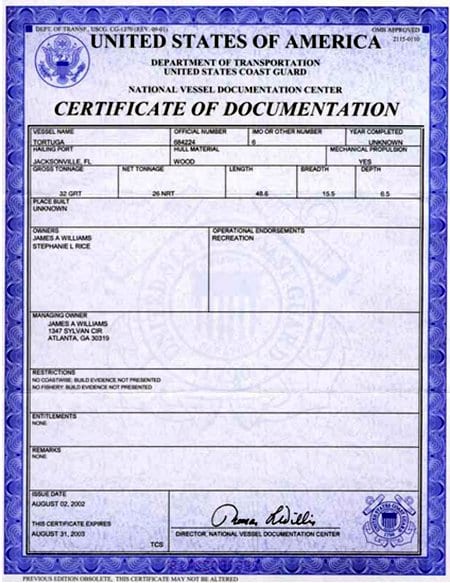 By Bob Currie, Recreational Boating Safety Specialist
By Bob Currie, Recreational Boating Safety Specialist
U. S. Coast Guard Auxiliary Base Galveston Flotilla
It is not enough to just own a boat; you must have your papers with you. It’s no different from driving a car. You have to have your driver’s license, registration, and proof of insurance to drive a car. Let’s look at the papers you are required to have when operating a boat.
The Base Galveston Flotilla of the US Coast Guard Auxiliary operates out of the US Coast Guard base on Galveston Island. They aid the Coast Guard by providing maritime observation patrols in Galveston Bay; by providing recreational boating vessel safety checks; and by working alongside Coast Guard members in maritime accident investigation, small boat training, providing a safety zone, Aids to Navigation verification, cooking in base and station galleys and aboard cutters; and as drone pilots on the Coast Guard Drone Team.
Boat Registration
Although it is a waterproof light plastic card that can be carried in your wallet, I recommend that you put your boat registration card, known as the Certificate of Number for a Vessel, in a waterproof box and store it on your boat. Quite often the boat operator is other than the registered boat owner, and it the boat owner has the registration card in their wallet, the boat operator could be facing a $250 fine (in Texas) for not having the card in their possession. If someone else operates your boat, be sure to tell them where the card is located.

Vessel Documentation
Vessel documentation is a national form of registration. It is one of the oldest functions of our government, dating back to the 11th Act of the First Congress. Documentation provides conclusive evidence of nationality for international purposes, provides for unhindered commerce between the states, and admits vessels to certain restricted trades, such as coastwise trade and the fisheries. Since 1920, vessel financing has been enhanced through the availability of preferred mortgages on documented vessels.

Are There Different Types of Documentation?
Yes. Certificate of Documentation may be endorsed for fishery, coastwise, registry, or recreation. Any documented vessel may be used for recreational purposes, regardless of its endorsement, but a vessel documented with a recreational endorsement only may not be used for any other purpose. Registry endorsements are generally used for foreign trade.
What Vessels May Be Documented?
A vessel that measures at least five net tons and, with the exception of certain oil spill response vessels, that is wholly owned by a citizen of the U.S. may be documented. Many people are under the impression that documentation has a minimum length requirement. Not so. It is all about total vessel volume. Net tonnage is a measure of a vessel’s volume. It should not be confused with the vessel’s weight, which may also be expressed in tons. Most vessels more than 25 feet in length will measure five net tons or more, so you can see where people get the idea that documentation is about vessel length.
What Vessels Must Be Documented?
Vessels of five net tons or more used in fishing activities on navigable waters of the U.S. or in the Exclusive Economic Zone (EEZ) or used in coastwise trade must be documented unless the vessel is exempt from documentation. Coastwise trade is generally defined as the transportation of merchandise or passengers between points in the U.S. or the EEZ. In addition, towboats operating between points in the U.S. or the EEZ or between the EEZ and points in the U.S. and dredges operating in the U.S. or the EEZ must be documented. Vessels that do not operate on the navigable waters of the U.S. or in the fisheries in the EEZ, are exempt from the requirement to be documented. Also exempt are Coastwise qualified, non-self-propelled vessels used in coastwise trade within a harbor, on the rivers or lakes (except the Great Lakes) of the U.S. or the internal waters or canal of any state.
What Are the Requirements for Documentation?
The basic requirements for documentation are to demonstrate ownership of the vessel, U.S. citizenship, and eligibility for the endorsement sought. If the vessel is new and has never been documented, ownership may be established by submission of a Builder’s Certification, naming the applicant for documentation as the person for whom the vessel was built or to whom the vessel was first transferred. Also acceptable are a transfer on a Manufacturer’s Certificate of Origin, a copy of the State Registration or Title, or foreign registration showing that the applicant owns the vessel. In the case of a previously owned vessel, the applicant must present bills of sale, or other evidence showing transfer of the vessel from the person who last documented, titled, or registered the vessel, or to whom the vessel was transferred on a Builder’s Certification or Manufacturer’s Certificate of Origin.
Citizenship is established by verifying the applicant’s social security. In addition to individuals, corporations, partnerships, and other entities capable of holding legal title may be deemed citizens for documentation purposes. Corporations must be registered in a state or the U.S; the chief executive officer and chairman of the board of directors must be U.S. citizens, and no more than a minority of the number of directors necessary to constitute a quorum may be non-citizens. In addition, at least 75% of the stock must be vested in U.S. citizens for a coastwise or fisheries endorsement.
Evidence that a vessel was built in the U.S. is required for a vessel which is to be used in the fisheries or coastwise trade. Build evidence is normally established by submitting a Builder’s Certification. That form must be completed by the person who constructed or oversaw the construction of the vessel or an official of the company that built the vessel who has examined the records of the company to determine the facts of build. The Original Builder’s Certification or Facts of Build Letter must be presented with your submission. A copy will not be accepted.
What Are the Vessel Name and Hailing Port Marking Requirements?
Documented vessels do not display their official numbers on the outside of the hull but are identified by the name and hailing port. The application for documentation must include a name for the vessel composed of used to solicit assistance at sea; may not contain or be phonetically identical to obscene, indecent, or profane language letters of the Latin alphabet or Arabic or Roman numerals and may not exceed 33 characters. The name may not be identical, actually or phonetically, to any word or words, or to racial or ethnic epithets. Once established, a vessel’s name may not be changed without application, fees, and the consent of the Director, National Vessel Documentation Center. There is no rule against duplication of names for documented vessels, so hailing ports are helpful in identifying vessels.
How Do I Mark My Vessel?
The official number assigned to documented vessels, preceded by the abbreviation “NO.” must be marked in block-type Arabic numerals at least three inches high on some clearly visible interior structural part of the hull. The number must be permanently affixed so that alteration, removal, or replacement would be obvious and cause some scarring or damage to the surrounding hull area. Most of the vessels that I inspect have their documentation number displayed in their engine rooms.
The name and hailing port of a recreational vessel must be marked together on some clearly visible exterior part of the hull. The vessel name of a commercial vessel must also be marked on the port and starboard bow and the vessel name and the hailing port must also be marked on the stern. All markings may be made by any means and materials that result in durable markings and must be at least four inches in height, made in clearly legible letters of the Latin alphabet or Arabic or Roman numerals. The hailing port must include both a place and a State, Territory, or possession of in the United States. The state may be abbreviated. I do Vessel Safety Checks for many documented recreational boats. The four-inch height requirement is different from the three-inch height requirement for the usual state registration letters and numbers, and some newly documented boats I have inspected have failed the inspection because they did not adhere to the four-inch height rule.
Is a Documented Vessel Exempt from State Jurisdiction?
You wish! No, all documented vessels must comply with the laws of the state in which they are operated. The vessel’s document must be shown to state law enforcement personnel upon their demand. States may require documented vessels to be registered (but not numbered) and to display state decals showing that they have complied with state requirements. In Texas, you must register your boat, but you do not display your TX numbers if it is documented. In Texas just the registration decal is required to be displayed in the usual locations on the port and starboard sides of the hull.
To Name or Not
While displaying your boat name and hailing port is a requirement for documented vessels, it is also an option for any boater to display their boat name and hailing port. Whenever we go on boat patrol of the area marinas, we like to read all the boat names and hailing ports and imagine what type of person owns the boat. Naming your boat is an old tradition. My first boat was a small pirogue co-owned with a friend. We named it “Petunia,” (long before John Fogerty wrote “Born on the Bayou”) and we paddled that boat all up and down Pine Island Bayou when we were growing up.
Trailer Registration
Although the Coast Guard won’t ask you for it, when you trailer your boat you are subject to being asked for your trailer registration. In Texas we have to display a current registration sticker on our trailer license plate, but we also have to have the actual registration document available for inspection when asked for it by a law enforcement officer. I keep a copy of my trailer registration in both of my vehicles, which happen to be trucks.
Summary
I would say that about a third of the recreational boat vessel safety checks I perform that fail the inspection do so because the owner doesn’t have the proper papers. The requirements aren’t numerous; you have to have your Certificate of Number for a Vessel, your Certificate of Documentation (if documented), and your trailer registration if you are towing. Be sure to keep your papers in a location that you can remember; I have had boat owners tear their boat apart trying to find their documents.
For more information on boating safety, please visit the Official Website of the U.S. Coast Guard’s Boating Safety Division at www.uscgboating.org. Questions about the US Coast Guard Auxiliary or our free Vessel Safety Check program may be directed to me at [email protected]. I am available to perform free Vessel Safety Checks, and I will come to your location to perform them. SAFE BOATING!
[June-29-2021]

 Posted in
Posted in 
























